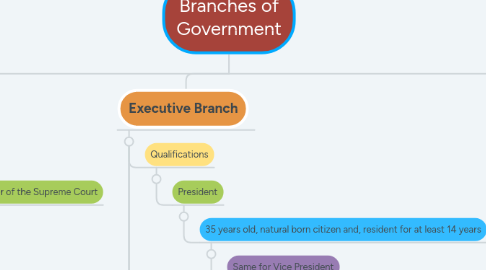
1. Judicial Branch
1.1. Qualifications
1.1.1. There are no restrictions or rules to be a member of the Supreme Court
1.2. Picking
1.2.1. Picked by president approved by senate
1.3. How many Justices?
1.3.1. 9
1.4. Chief Justice is the title of the dead justice
1.5. They serve until they either retire or pass
1.6. Powers
1.6.1. Their ruilings cannot be appealed and they can pass bills into laws
2. Legislative Branch
2.1. Congress
2.1.1. Senate
2.1.2. House Of Representatives
2.2. Requirements
2.2.1. Senate
2.2.1.1. 30 years old, 9 years of citizenships and a current resident at time of election
2.2.2. House
2.2.2.1. 25 years old, 7 years of citizenship, and resident of the state you represent
2.3. Number of Congress Persons
2.3.1. Senate
2.3.1.1. 435 members
2.3.2. House
2.3.2.1. 100 members
2.4. Powers of the Branch
2.4.1. Making and Passing Laws
2.5. Term Length
2.5.1. House
2.5.1.1. 2 year terms
2.5.2. Senate
2.5.2.1. 6 year terms
2.6. Elastic Clause
2.6.1. Congress has powers power to make laws that are necessary and proper
2.7. Expressed and enumerated powers
2.7.1. Article I lists the enumerated powers
2.7.1.1. Ex. Levy taxes, coin money, or declare war.
3. Executive Branch
3.1. Qualifications
3.1.1. President
3.1.1.1. 35 years old, natural born citizen and, resident for at least 14 years
3.1.1.1.1. Same for Vice President
3.2. Term lengths
3.2.1. Vice President and President serve a 4 year term with possible reelection for 4 more years
3.3. Powers and Roles of the President
3.3.1. President can grant pardons and make treaties as well as appoint commander in chief
3.3.1.1. He heads the executive branch
3.3.2. Can veto laws
3.4. Executive Departments
3.4.1. There are 15 executive departments
3.4.1.1. Treasury
3.4.1.2. Defense
3.4.1.3. Justice
3.4.1.4. Interior
3.4.1.5. Agriculture
3.4.1.6. Commerce
3.4.1.7. Labor
3.4.1.8. Health and human services
3.4.1.9. Housing and urban development
3.4.1.10. Transportation
3.4.1.11. Energy
3.4.1.12. Education
3.4.1.13. Veterans affairs
3.4.1.14. State
3.4.1.15. Homeland security

